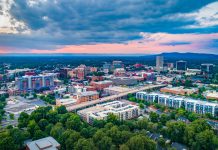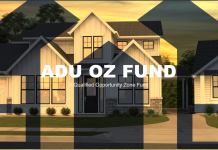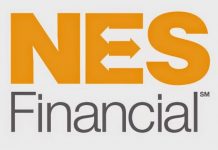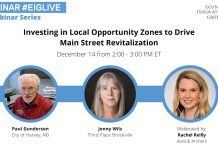ADUs (accessory dwelling units) have become more prevalent in recent years. Also referred to as mother-in-law suites, multigenerational units, and in-law units, ADUs offer both environmental and financial benefits for investors and tenants alike. Paired with a Qualified Opportunity Zone project, the advantages of ADUs are even greater.
Adam Stone is a licensed Real Estate Broker, member of the California Bar, and CEO and fund manager of ADU OZ Fund. He has expertise in various aspects of both residential and commercial real estate including acquisition, management, entitlements, litigation, joint ventures, municipal codes, and San Diego zoning and ordinances.
Click the play button above to listen to our conversation with Adam.
Episode Highlights
- Advantages of accessory dwelling units (ADU) and how to go about designing, building and funding ADUs.
- How ADUs can help with today’s nationwide housing shortage and soaring real estate prices.
- Why ADUs are increasing in popularity and why pair ADUs with opportunity zones incentives.
- The different types of ADUs, the benefits of each, and their potential impact on the property value and neighborhood quality.
- Laws around ADUs, specifically in California, and what to know about zoning regulations and restrictions.
- How to achieve the full tax benefits of ADUs and the specific tax incentives they provide.

Featured On This Episode
Industry Spotlight: ADU OZ Fund LLC
ADU OZ Fund LLC is a Qualified Opportunity Zone Fund creating new affordable housing in San Diego and other desirable markets that targets and acquires 1–4-unit properties within zoning designations that allow the addition of multiple ADUs for more housing.
Learn More About ADU OZ Fund LLC
- ADU OZ Fund LLC
- ADU OZ Fund LLC on LinkedIn
- Email: info@aduozfund.com
About The Opportunity Zones Podcast
Hosted by OpportunityDb.com founder Jimmy Atkinson, The Opportunity Zones Podcast features guest interviews from fund managers, advisors, policymakers, tax professionals, and other foremost experts in opportunity zones.
Show Transcript
Jimmy: Welcome to The Opportunity Zones Podcast. I’m your host, Jimmy Atkinson. Joining me today on the podcast is Adam Stone. He is a real estate attorney, broker, and now fund manager of ADU OZ Fund, a qualified opportunity zone fund that uses accessory dwelling units as an option to complete value-adds for multifamily residential projects. Adam joins us today from San Diego, California. Adam, welcome to the show.
Advertisement
Adam: Hey, Jimmy. Thanks for having me. I’m a huge fan of the show.
Jimmy: Awesome to hear. Adam, thanks for joining us today. Pleasure to be with you. This is the first podcast interview that I’m recording in 2022. We’re in the first week of January here. So, New Year, new podcast episode, looking forward to seeing what this year brings for opportunity zones. But let’s turn to you now, Adam, and focus on your fund, which features accessory dwelling units, or ADUs. It’s the first such OZ fund that I’ve come across. So I’m curious to learn more about it during the course of the episode today, during the course of our conversation, but to start us off, a very basic question. What is an accessory dwelling unit exactly?
Adam: Sure. Well, an accessory dwelling unit, ADU for short, is a separate dwelling area on the same property as a primary detached home. Generally, they’re up to 1200 square feet. And I think people are familiar with them. If you’ve ever watched Fresh Prince of Bel-Air, Will and Carlton, they live down in the pool house. That’s an accessory dwelling unit. If you watch “Happy Days,” the Fonz, where he lived, above the garage, that was an accessory dwelling unit. Now, the regulations and laws in California and other areas of the country have opened up to such a point where value-add in the development space, through the use of accessory dwelling units on single-family residential properties, is creating a large market for what we’re looking to do. And we’ve already had some success with that process already. So we’re excited to create a qualified opportunity zone fund to incorporate that model into what we’re already doing.
Jimmy: That’s great. Yeah. So, essentially, it’s oftentimes a guest house, or a pool house, or a carriage house, or maybe an extra apartment that’s built up above the garage, just anything like that. So we’ll refer to all that generally as “ADU” throughout the course of today’s episode. So, you touched upon this in your last answer, but the bigger macro picture, Adam, is that there’s a housing shortage in this country. And we’ve covered that topic on several previous episodes of The Opportunity Zones Podcast, and particular areas of the country have bigger housing needs than others. And California is certainly no exception to that fact, especially lower-income housing, affordable housing, workforce housing. And oftentimes the solution is we just need higher-density housing in a lot of these locations. I think ADUs help provide that. Can you add some additional color there, though, Adam? How else can ADUs help to address that issue?
Adam: Sure, Jim. I mean, you hit it right on the spot in terms of the housing needs and the crisis that the whole country is going through. And I think accessory dwelling units just provides another option, another tool for addressing that situation, addressing that problem. You know, in terms of what we’re doing in San Diego and what the laws allow, you know, like you mentioned, there’s the ability to convert garage space, and even, if you have a piece of property that has a larger lot, and there’s space on that property to build out, you can build in accessory dwelling units. And it does just provide another option for people who want to, you know, help build in those new living spaces, those new areas, for all sorts of people who are needing it. You mentioned affordable workforce housing. We’ll talk a little bit more about that. But yes, I mean, it’s just another tool, an option. I think it’s a great way to add in value for people looking to help address that issue.
Jimmy: And has there been a push by certain communities around the country, and maybe you can speak specifically about San Diego, because I know that’s where you are now, and that’s where your fund has some focus in? In terms of changing the local regulations and zoning laws to allow for this, what exactly is unfolding in that regard?
Adam: Since the start of 2020, you know, we’ve had laws across the state that have opened up the ADU development space. And San Diego has been at the forefront, I would say, in terms of creating laws that allow for ADU development in areas that have the highest density issues, and have the highest need for affordable housing and affordable rents. And they even allow for some of the regulations to not only serve as a tool to create rentable ADUs, but also ADUs that can be, you know, sold and resold to the community, depending on the involvement of nonprofit organizations. So, you know, I think with the creation and enactment of SB8, 9, and 10, and for those who don’t know, that’s state bill, Senate Bills 8, 9, and 10, in the state of California, those are even more expansive regulations, that allow for the development of single-family housing, and provide for more avenues to bring in units and bring in solutions for this growing problem.
Jimmy: Good. And I’ll be sure to link to those Senate bills, California Senate bills 8, 9, and 10 in the show notes, for today’s episode. And as always, you can find those show notes at opportunitydb.com/podcast. What does it typically do to the value of the property? Let’s say the case of a single-family home, there’s a little bit of room on the property to develop an ADU, maybe a guest house or a pool house, you know, what have you, to increase the density, and maybe add another bedroom and bathroom to the property in an ADU. How does that affect the value of the property, typically?
Advertisement
Adam: You know, it’s just a common answer from an attorney. It all depends. It comes down to redeveloping something in your backyard, where you’re building ground-up, then you’re gonna add in the most value compared to maybe an area in your house that could be walled off and turned into its own separate space, which is called a junior ADU in a lot of areas in San Diego, junior accessory dwelling unit, or if you’re converting a garage, and doing the garage conversion. But just to give you a small example, we have a project right now that is in the first phase of two phases of accessory dwelling unit value-add. And the first phase was taking the existing home, a two-bed, one-bath property, with an attached garage, rehabbing the home, and then extending the garage out slightly to create its own ADU in that garage, converting the garage into a two-bed one-bath accessory dwelling unit. The original purchase price for that home was about $385,000. We’ve had appraised value for just the duplex, or I should say, the ADU conversion, at about $775,000 closer to $800,000 just for the rehab and the conversion there. So, you know, there is a pretty significant increase in value, especially if you’re doing it in a way that’s, you know, rehabbing existing structures, or adding in new value and new square footage to the property.
Jimmy: Right. Yeah, that’s pretty substantial return on investment, then. Pretty substantial value increase. In some ways, I would imagine you could pretty quickly add on some sort of ADU to the home, and then just flip it and get out within a year or two if you needed to. But I would imagine, turning our attention now to your opportunity zone fund, that you wanna have a longer holding period within your ADU OZ fund. But correct me if I’m wrong, and also tell me a little bit more about your fund. What’s your investment thesis exactly, and what are you doing within your fund?
Adam: Right. I appreciate that. And I think the idea of taking that strategy of finding properties that have that value-add potential, we are looking, like I said, the first phase of these projects is taking the existing structures, within the fund, of rehabbing those structures, getting those to a livable, rentable status. But then from there, a lot of our projects that we target are able for an additional significant value-add on their open backyard space. And taking that same example, I mentioned the home with originally a two-bed one-bath with a garage, now through the first phase, the home is now a three-bed, two-bath, with the two-bed one-bath accessory dwelling unit. In the backyard space, the second phase is to add in eight additional one-bed, one-bath units, that would allow for us to go from having one unit originally now to having 10 units. And then, from there, you know, holding that property, cash flowing through the rental income, for the eventual sale exit, after the 10-year hold is established, to get the step up in tax basis. So we’re using that as a way to, again, bring in, you know, the accessory dwelling units, but do it in a way that provides value for our investors and then the community as well. Because these properties are going to incorporate parking, incorporate outdoor community spaces, and things like that. So it’s adding units in a way that doesn’t add in unnecessary congestion.
Jimmy: Oh, okay. That’s pretty substantial then. You’re essentially taking a single-family home with a large backyard and you’re converting it into a multifamily property, in some sense, if I understood you correctly.
Adam: No, that’s correct.
Jimmy: Okay. Good. Tell us a little bit more about your fund. How much are you raising? What areas are you focused on, and what types of property types and rates are you targeting?
Adam: In terms of property types, again, we’re looking at the residential mixed-use space. And then, from there, we are looking for investors who have at a minimum of $50,000. But our raise, initial round, would be $25 million, with a max raise of $250 million. So, within that time span, we’re looking to acquire properties that fit that model in terms of the value-add space, not only in San Diego. We have other markets that we’re targeting. I’m originally from the Ann Arbor, Michigan area, Detroit area, so, you know, there are opportunity zones in those areas that are very attractive. My partner, Matt Williams III, he has a development background in the Atlanta and Dallas area. So, you know, we’re targeting those areas as well, and have some projects that are already in mind for potential expansion.
So, I think the whole idea for our fund is to add dwelling units, not only through accessory dwelling units, but the housing options that fit that market. So, you know, I think we will see accessory dwelling units continue to expand in their regulations across the country. But, you know, until they catch up in other areas, I think there are definitely options that still fit what our fund’s mission is, and adding in those units in a way that provides not only more housing for rentals but, again, more housing for new homeowners, homeowners that wouldn’t have had an opportunity to be homeowners unless there were funds like this and developments like this.
Jimmy: As you mentioned four different markets, San Diego, obviously, and then you also mentioned Ann Arbor, Dallas, Atlanta, what do you like about those particular markets?
Adam: They all share some of the same characteristics in terms of different demographics and sizes, but they’re all areas that are highly sought after. They’re seeing growth and, you know, continued growth in a way that is driving prices up to heights, you know, there’s just new for those areas. So we’re seeing those… You know, Dallas, in particular, they’re starting to incorporate more ADU laws into their own regulation. So, again, that provides even more value for potential developments, you know, things that could have been subdivision build-outs in the past, that might now turn into subdivisions with accessory dwelling units incorporated into it. Again, more value added to the property, more housing added, you know, immediately, to provide for the community’s needs. So, yeah, I think those four areas all serve as areas of high need, just based on their growth, and places that we’re comfortable with and have seen the growth over a span of 10, 20 years, sometimes.
Jimmy: The congressional intent of the opportunity zone legislation in the first place was really to help spur economic activity, and social impact, really, in a lot of economically downtrodden areas throughout the country. How is your fund and the projects that you’re developing helping to deliver on that promise of creating social impact?
Adam: You know, we’re looking at it for three areas, not only just adding in the housing, but also through the job creation that comes into play from the construction, and the ancillary businesses that are going to be necessary to support more of the community. We have our own ideas in terms of what some of those businesses would be, to help serve the community and also fill needs that are already there. But at the same time, I think, in the end, if you’re adding the housing, bringing in the job creation, both through the construction and the ancillary businesses, and then, on the other end, one area that we’re looking to build more support for, and hopefully, these are some changes that we see with the opportunities zone tax laws down the line is just the ability to incorporate more community involvement at the investor level. And I think that’s something that’s important to us too, because we definitely want involvement at all levels, and want people to share in the growth that should happen, and using the fund.
Jimmy: Did you say that was a law that you’d like to incorporate some of that additional community involvement?
Adam: I think in, just in terms of some of the possible changes and ways to expand and open things up. I know that in some states, I believe Ohio is one state that has allowed at a state level to give at least some benefit to the opportunity zone investment for people who aren’t using capital gains. So I think that’d be an area that if possible we could, let’s say, incorporate in California, or find some way to get, help build in involvement from the community as a whole.
Jimmy: Yeah, I think there’s a lot still left to be written in the story of opportunity zones. I do think some additional changes to the law, and changes to some of the regulations could help open it up a lot more. So yeah, that’s an interesting idea, I think, there, Adam. Well, what can you tell us a little bit more about the team at ADU OZ fund? You mentioned your partner, Matt Williams, briefly, a few moments ago. Give us a little bit more background on him, and on yourself as well, and the experience that you two have.
Adam: Okay, yeah. Matt is, he’s a retired military veteran. He, since serving in Afghanistan and being active, he has been in the development space. And like I mentioned, he has familiarity and success in multiple different markets. I mentioned Dallas and Atlanta, but also areas in Pennsylvania, obviously, in San Diego, other parts of California. So, he’s definitely the construction development manager in terms of knowing how to execute these projects and put them together. On my side, I have a background as a real estate and business attorney. I’m also licensed as a real estate broker. So, you know, I really focus on knowing how to navigate the laws, and combine the different areas of local, state, and federal law, to try to synthesize a formula that fits our model, and that’s compliant with what’s out there, but also allowing us to take advantage of the laws and codes that are designed to spur on this type of development. So, you know, I think we create a great team. Outside of that, you know, we do have, we keep a very experienced staff of experts and consultants at the ready, and they’re on our chain, just in terms of helping us navigate the opportunity zone tax laws, and just design and build out our projects in general.
Jimmy: Good. Turning back to your fund for a moment now. You just launched it, just within the last few days, end of 2021, or maybe beginning of 2022 here. You’re raising $25 million. What types of properties have you already identified? What does your pipeline look like exactly?
Adam: So, right now, we have a couple infill lots that we’re redeveloping. Those are already under contract, and more are working towards just the design for what the build-out would be on those. And then, I believe I mentioned earlier, in the Atlanta region, we have some connections to a subdivision that is located with an opportunity zone that is needing to be finished off, built out. And that’s another area, again, that we would look to potentially bring in the use of accessory dwelling units if it made sense. But, you know, in the San Diego space, we have multiple other projects that are in the pipeline, that fit that larger-lot, mixed-use or single-family zoning designation that is primed for value-add.
Jimmy: And, wanna speak about some of the challenges now with managing and raising money for an opportunity zone fund. It’s a heavy lift, just doing the types of development that you’re undertaking to begin with, but then you’re also layering the opportunity zone tax benefit on top of it. And you’re also dealing with a lot of local regulations and zoning laws as well, and local tax incentives and tax benefits. What have been some of your biggest challenges so far in terms of getting this fund up and running, and developing these properties and raising money?
Adam: No, that’s a great question. I think, like you said, there’s a lot of different areas and directions to go into, to really cover all of your bases in terms of building relationships, and making sure you’re covering those different levels that, the need that you want to make sure the fund moves in the right direction. I think, for us, we see it as a challenge but a opportunity to put together different collaborations that may not have always been used or utilized to put these types of projects together. For example, we are working with nonprofits and other organizations that could immediately use this housing to build support and traction for the projects, that would allow, you know, in a sense, for it to gain some more familiarity and comfort with this type of accessory dwelling unit value-add.
And, you know, I think just in general, accessory dwelling units have met some negativity from people who may not want them in their neighborhoods, but I think it’s impossible to deny the need for housing. So, you know, I think what we’re looking to put together, and how we’re looking to execute, you know, that’s why I mentioned earlier, the need for adding in parking and adding in some of those community amenities that allow us to say, hey, you know, we’re looking to address this problem. We’re looking to provide a resolution to this situation that really fit this need, but at the same time, doing it in a way that still is conducive to a quality neighborhood, and building community in a way that helps revitalize it.
Jimmy: Very good. Well, Adam, it’s been a pleasure speaking with you today and learning more about accessory dwelling units and your ADU OZ fund. Before we go, though, can you tell our listeners where they can go to learn more about you and the ADU OZ fund?
Adam: Sure. Thanks again, Jimmy, for having me on the show. For all the listeners who wanna get more information, please, you can reach out to us at info@aduozfund.com. Visit our website at www.aduozfund.com, or you can even reach out with a phone call at 619-704-2477.
Jimmy: Perfect. And for our listeners out there today, I will, as always, have show notes for today’s episode on the Opportunity Zones Database website. You can find those show notes at opportunitydb.com/podcast. And I’ll be sure to link to all of the resources, and I’ll even list that phone number as well, that Adam just gave, and all the other resources that Adam I discussed on today’s show will be linked there as well. Adam, thanks again for joining me today. Been a pleasure.
Adam: I appreciate it. And one more thing. I did wanna mention @aduozfund is our Instagram handle. Please follow us, and we’ll keep you updated on our projects and our progress for everything going on.
Jimmy: Fantastic. And we’ll link to that in the show notes as well. Thanks, Adam.
Adam: Thanks, Jimmy. Appreciate your time. Thank you.









































